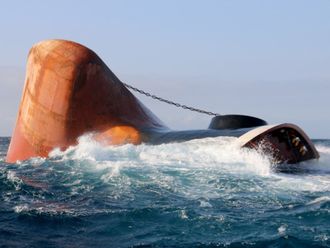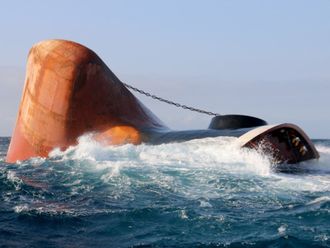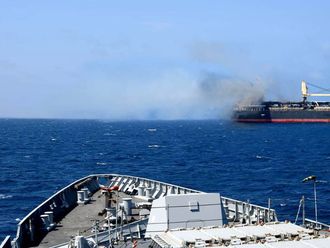Abu Dhabi: The UAE, represented by the Emirates Red Crescent (ERC), intensified its humanitarian giving campaign in Yemen in 2017, by contributing to the development of the country’s six primary sectors: education, health, security, relief, infrastructure and housing, after the wave of destruction inflicted by the Iran- backed Houthi militias on the nation’s economy.
Receiving widespread local and international acclaim, the total aid provided to Yemen between April 2015 and November 2017 by the UAE reached Dh9.4 billion, a staggering figure reflecting the determination of the country’s wise leadership to support the future of Yemen, in line with the objectives of the Saudi-led Arab Coalition to liberate the country.
The ERC has focused on providing relief aid while seeking to ease the suffering of the Yemeni people across the country.
With regards to the health sector, the ERC has implemented its development plans according to its strategy to develop medical facilities and meet the serious shortage in the supply of medications and medical personnel and equipment.
The ERC has also helped combat diseases and epidemics including cholera in many areas.
Dr Nasser Baoum, Minister of Health in the Legitimate Yemeni Government, has many a time lauded the ERC’s key role in improving the health sector in Yemen.
Baoum noted that 2017 witnessed the launch of many hospitals and programmes to provide equipment and medical personnel to the country.
He affirmed that the UAE has succeeded in improving the lives of Yemenis while bringing them hope, adding that the UAE’s efforts have played a major role in combating cholera and reducing its spread through the dispatch of medicines and vaccinations, including an airlift carrying 100 tonnes of medications and supplies.
The UAE has also provided $100 million (Dh367 million) to support the efforts to combat the epidemic, as well as 10 containers of cholera medicine, which were received by the World Health Organisation (WHO) officials for delivery to beneficiaries through its regional centre and health offices in the country’s various governorates, he further added.
He also noted that the Ministry of Health of the legitimate government has received dozens of medically equipped vehicles through the WHO, to distribute medicine around the country’s governorates.
In 2017, the ERC continued to support the National Programme to Combat Malaria in Yemen, by delivering medicine to fight the disease to relevant local authorities, as well as 100,000 insecticide-laced bed nets.
The ERC has intensified its efforts to restore and launch hospitals and medical centres across various Yemeni governorates, after supplying them with ambulances and basic medical equipment and devices, to provide the best level of treatment services.
Last year, the ERC inaugurated the General Hospital in Al Najdayn, Hadhramaut, as well as the Hijr Hospital, Ataq Central Hospital, the General Hospital in Mocha and Al Sadr Centre in Mukalla District. It also restored the health facility in Shaqra Abyan, a health centre in Arqa, Shabwa, and other medical facilities in other governorates.
The ERC also launched the first free surgical camp in Ataq District, Shabwah Governorate, and supported child immunisation campaigns by providing solar refrigerators while presenting 20 ambulances to the WHO.
The UAE has prioritised the education of Yemenis, which reflects its desire to create a promising future for them. It has also exerted considerable efforts to secure the education system, after its destruction by the Houthi militias.
Abdrabo Al Mehwali, Deputy Minister of Vocational Education in the Yemeni Government, has praised the ERC’s key role in restoring the education sector in the country’s liberated areas.
He also highlighted that the UAE’s generous support while noting that the country is keen to return millions of Yemeni students to their schools.
The UAE also provided four academic halls in the Science College of Aden University with 200 seats, projectors and computers. It also launched the Abou Madyan Vocational Centre in Sabr, as well as a health centre, along with the headquarters of a vocational centre, and the office of the Deputy Minister of Vocational Education.
The ERC followed up these efforts by launching many schools such as Zaghfa School in Ash Shihr District, Be’r Ali in Shabwa Governorate, Ar Raydha School in Hadhramaut, Al Sha’abat School in Adh Dhlia’ah District, the Office of Education and Naaj and the Samia and Mabrouk schools in Lahij Governorate, as well as the Azzan Boys School and other local schools, besides the Hafsa Elementary Education School. The ERC is continuing its initiative to restore many schools and institutions that were destroyed by Al Houthi militias.
The ERC also distributed hundreds of buses to Yemeni schools and universities, to ensure smooth transportation for students, especially those who live in remote rural areas.
The ERC launched new initiative “School Bag” at the start of the new school year in many governorates, and distributed school clothes to many needy Yemeni families.
Regarding the restoration of the energy sector and housing projects, the ERC launched hundreds of infrastructure and housing developments in 2017.
On the energy sector, 2017 witnessed the supply of urgent energy aid, with the aim of providing 100 additional megawatts worth $50 million or Dh183.5 million, and a MoU was signed to restore the 120-megawatt Al Makha Power Station.
Last year, the ERC restored and inaugurated Al Makha Steam Station, as well as a development project to restore power lines in Al Rayyan, East of Mukalla, and the 10-megwatt power station in Lahij Governorate.
Regarding the water sector, the ERC launched a water campaign for the people of Jahaf District, Dhale Governorate, as well as other projects to support the water sector in Al Anad, Al Ateiba, Al Faysh in Shabwa Governorate, and Al Osbah and Assam in Al Sum in Hadhramaut, as well as Maghras Naji in Sabr Directorate.
The ERC also announced projects to dig wells in many areas, including 18 artesian wells in the Hadhramaut Desert, six on the West Coast, and five in the fields of Falak, East of Mukalla.
Regarding the rebuilding of houses that were destroyed by the Houthi militias, the ERC reconstructed 17 houses as part of the first phase of rebuilding Al Makha while pledging to build 17 further houses and signing a partnership agreement with the governors of Aden, Lahij and Dhale, with the aim of supporting local development projects.












